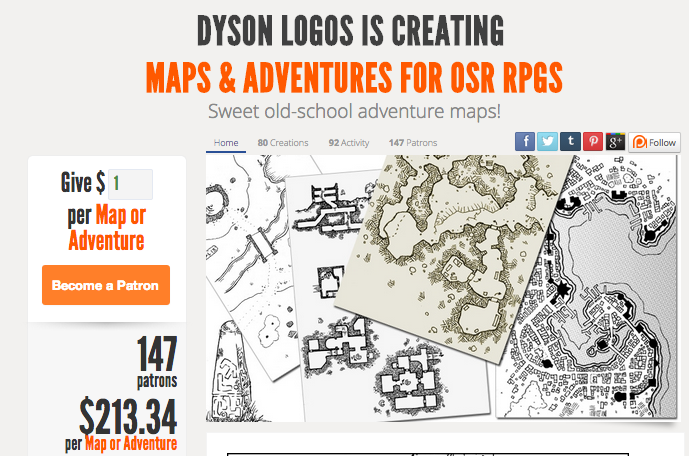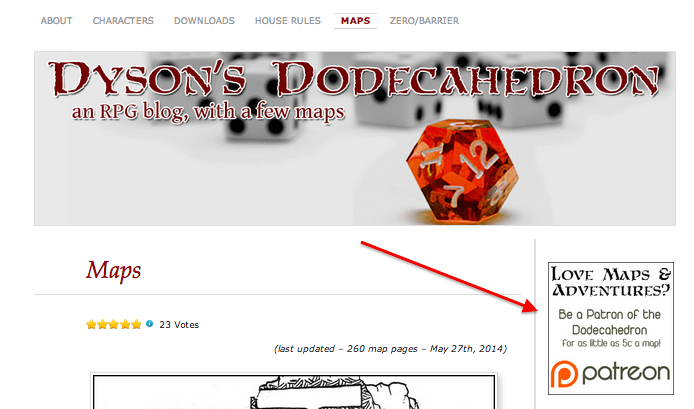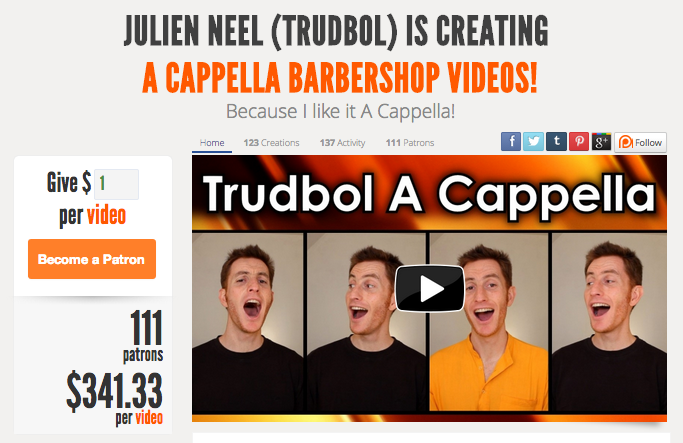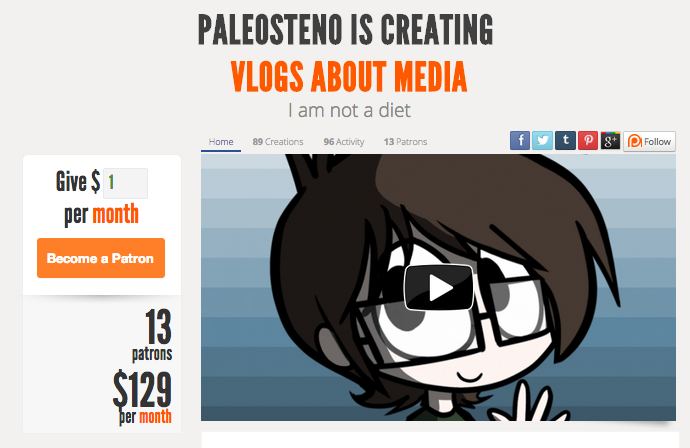Our past post on Kickstarter vs. Patreon gathered a lot of attention from readers, many having never heard of Patreon’s subscription-based crowdfunding platform. Since then, the website has been gathering a lot of steam (they raised a $15 million series A) and even Richard Bliss, the founder of the ‘Funding the Dream on Kickstarter’ podcast, has turned to Patreon to finance the show.
I’ve decided to do a follow up to my previous article and shed some light on how, as a creator or publisher, you can use Patreon to fund your artistic, entrepreneurial, or entertainment projects. I had huge help putting this article together from some of the awesome members of the . I’ve included a banner/link to the group below.
This group formed during the Patreon live webcast and is a great place to ask questions and get feedback! You can also promote your project and ask for feedback on our forum.
That being said, let’s get down to business. I interviewed 3 separate Patreon creators who have all successfully attracted supporters for their projects. They were nice enough to share their thoughts on the platform and what it takes to gather a following. Be sure to check out their pages and leave a comment below!
Maps & Adventures For Osr Rpgs – 80 Creations, 147 Patrons, $213.34 per creation.
The Pitch
“I love drawing old school pen-and-paper dungeon and fantasy adventure maps. I also love making adventures with them, but I draw a lot more maps than I make adventures”
“This is your chance to get involved in my mapping. You sponsor my map drawing, and I can afford to keep drawing maps! I post 1-2 maps a week to the Dodecahedron, and throw in an adventure every few months.”
“There is no guilt here. I produce maps, you enjoy maps. You can keep on enjoying them and I’ll probably keep producing them regardless of whether or not you patronize my work. Patronage exists as a way for you to say thanks with financial assistance, which in turn makes it easier for me to continue to create.”
Dyson Logos Website & Pitch
How did you hear about Patreon and what separates it from other crowdfunding platforms?
I’m a pen and paper RPG designer / writer / cartographer. I actually heard about it through some chatter among the RPG community on Google+ asking if anyone in the community of note was using Patreon and if it was a viable funding system. The general consensus was that it seems that there wasn’t anyone really doing anything with it in our field and that the few who were using it didn’t make it look all that viable.
The exception at that point was Epidiah Ravachol who is using it to put out a zine of fiction and RPG material and was already over $1k in funding at the time. Tony Dowler was also on Patreon at that point, but had a single Patron-only release. Outside of Tony, there was no one on Patreon doing RPG adventures or cartography and there was evidently some buzz going around the community, so I took the plunge.
The huge benefit of Patreon over any other method of crowdfunding is that I’m not getting paid, then releasing a product. Instead I’m making a product (like I have been for over four years) and people pay me afterwards. If I decide to stop making maps, no one is left upset that they paid into something and got nothing out of it.
Although the RPG community has a lot of successful Kickstarters, we’ve also seen some disasters where the money was received and spent, and no product was created or shipped. I am a LOUSY freelancer and tend to run really late on deadlines, and sometimes just quit commissions mid-stream. Being aware of this, Patreon is the perfect answer as I am not doing commissioned work, but am instead producing the same work I have been for my blog for the past few years.
I also really like the Patreon approach that the end product should be released for free. This meshes with my own creative process where I release my maps for free non-commercial use through my blog. It also means that the people coming in to back my work through Patreon have access to all my prior works and can see what they are getting involved in.
How did you reach 147 supporters?
I’ve been writing and drawing through my blog for five years now. Of my existing 147 supporters, I know two in person. The rest are people who I have met through the online RPG community. Some I do consider friends as we interact online on a weekly if not daily basis – but in response to the question they are my existing audience.
Patreon works best if you have an audience already. In my experience, people aren’t coming to Patreon looking for people to fund, they are coming to Patreon because someone who creates cool stuff is already using Patreon and has brought them there. Once they fund the artist they have come to support, some will look around for similar projects or artists that they can get involved with, but that’s a very minor part of the patron uptake.
I’ve been on Patreon since November 14th, 2013. I wasn’t sure if it would catch on. Since I release 8-9 maps a month and release them for free, I expected a small uptake amongst my readership. I privately announced my Patreon campaign through my Google+ circles a few days before the official launch of the campaign, asking people to critique the campaign. My goal was that I would have 100 supporters at 50c each within four months. Within three hours of asking people for the critiques I had already passed my first milestone goal ($15) and the next day was over the $30 mark. Turns out there was a pent-up demand to give me money!
Have you had people discover you on Patreon, or are you mainly driving your own traffic?
Maybe a few of my patrons discovered me through Patreon, but the vast majority are getting there through my own efforts and the efforts of a few other community members who actively work in the same field as I do on Patreon.
Do you have any tips or advice for creators looking to use Patreon?
Create. Don’t create FOR Patreon, create because you love to create and already do create. Understand that the Patreon model for most people involves a small build-up over time. If you don’t already have an established audience, starting up a Patreon campaign will not suddenly give you one, let alone one that is willing to pay money for your work.
Also, make sure that when your campaign goes “live” you already have some patrons. Think of it as a tip jar. Think of the person outside the grocery store playing guitar. Notice that there’s always money in the guitar case already. Even if the person just set up for the day. It is there so others see that it’s not just “ok” to give money, but that they aren’t alone in doing so.
This lesson applies to crowdfunding. There’s nothing like seeing someone with zero funding to make a person wonder if they should be funding them. The timid supporter has to see that there’s already support out there, that other people think it’s a worthwhile investment.
Look at Kickstarters. Look how much of the funding for a successful KS triggers at the last stretch. It’s not because the word has finally gotten out that the KS exists, it’s because people feel more confident putting their money in something that looks like a sure thing. An empty tip jar is the opposite of a sure thing. A tip jar that’s been empty for a few weeks? It might be enough to turn away even the slightly less timid supporter.
So consider getting some self-funding in there. Get some friends to support you, even at the lowest possible level. Hell, offer to pay them back in beer equal to their investment in you. Just get the tip jar started so the public sees that you get tips.
Also, make your goals personal. My initial goals were to improve my work (purchasing third-party art for my adventures, buying better work supplies) – things that would immediately improve the experience for the patron. But my bigger goals were personal. If I get X funding, I can buy booze! If I get Y funding, I can pay my rent! I originally put that in there as a joke… mostly.
The rent goal was inspired by James Raggi who publishes Lamentations of the Flame Princess (an awesome RPG). He did something similar for his stretch goals for his most recent Indiegogo campaign – every time we reached a stretch goal the backers got to vote on what it would entail and one of the options was that he’d pay his rent (to his wife) early. It got overwhelmingly voted in.
Not all your patrons want stuff for themselves, some are backing you because they want to give you money. Showing them how that money will change things for you gives them more impetus to fund you.
Do you like Patreon and do you think it is a viable alternative to monetization strategies like adsense and product placement?
It is incredibly viable monetization strategy – for the right product. The product that Patreon works for is one with low to no overhead and upfront costs and is a product you would be producing regardless of whether or not you have any patrons.
Look at the foundation of Patreon – it was put together for & by creators who were already creating product and releasing it for free. They also had other ways of monetizing their creations (commercial releases and collections), but you don’t have to spend a penny to enjoy Jack Conte’s work if you don’t want to. The Patreon model doesn’t extort money in exchange for product, what it does is encourages people to tip you (and tip you well) for the product after they already have the product in hand.
I’ve paid my rent every month in 2014 using the funds from my Patreon campaign. To say I “like” Patreon would be a gross understatement. Patreon has changed the way I create – every person willing to throw me a nickle for a new map is another inspiration to create. My art style has improved significantly since I started this campaign, partially because I can now afford better equipment, but mostly because of the additional inspiration from my patrons and the peer pressure of knowing that there are something like a hundred and fifty people PAYING me to produce this next map or adventure.
That said, it isn’t a full replacement for other monetization strategies. I still sporadically release new books compiling my works for those who don’t want to spend their time saving and printing every map from my blog and those books are part of what pays my day to day living expenses.
Basic marketing knowledge is essential to successfully monetizing anything. Understand your product, the market for your product, the pricing strategies that work for it (and Patreon is not always the best pricing strategy for some projects as I said above – if the product requires significant overhead costs, then Patreon is not the way to go), and how to best promote it.
Remember that editorial content is worth a thousand times more than promotional content – so get other people to promote your work instead of doing it all yourself. And remember that Patreon works best if you are creating because you love to create and you would be doing the creating regardless of the financial assistance.
Be sure to check out the Maps & Adventures For Osr Rpgs Patreon campaign and show your support here!
A Cappella Barbershop Videos – 123 Creations, 111 Patrons, $341.33 per creation.
The Pitch
“I enjoy creating a cappella harmonies, a vocal puzzle where I sing all the voices, from bass to tenor! I cover songs ranging from The Beatles, to old classics from the 1900s, to video game themes. ”
“I do everything on my own: I sing, record & edit everything from my desk in a small room, with basic equipment. Not much of a studio! I currently fund my productions on a string budget, with expenses for copyright & arranger fees, software, recording & lighting equipment, countless man hours editing audio & video together.”
“Now you can become an active supporter of my digital art! By tipping me as little as $1, you can help provide me with resources to improve & continue making free music videos for you all.”
Julien Neel’s YouTube Page
How did you hear about Patreon?
I follow Jack Conte on social media, so I was aware of Patreon in the early stages. I didn’t sign up right away, I wanted to wait for major players to sign up first and let people know Patreon was reliable.
KickStarter isn’t an alternative to Patreon for me: I release weekly a cappella videos, it’s not a one-shot project. I also don’t deliver a product, I just entertain. There is however a French alternative to Patreon called Tipeee. Patreon is US-based, it’s all in English and works in US Dollars, so quite a few people I know who are French native speakers aren’t pledging because of this problem. I decided to go with Patreon anyway because most of my followers on YouTube / Facebook / Twitter are English speakers. I’ve been asking Patreon to allow for other currencies and languages, but they’ve got a lot going on at the moment.
How did you reach 111 supporters?
It took me a few months to reach 100 supporters. I mostly advertise my Patreon account in my videos, by making a quick intro video to let people know they can make a pledge towards my music. Most of my supporters are fans. I have at most 10 supporters who are family or friends. It’s weird to ask for support to people I know in person, so I just tell them I make music and let them see decide. ![]()
Do you have any tips or advice for creators looking to use Patreon?
I say create your page on Patreon, sure, but make sure you have some content to show & an audience to show it to. People won’t pledge if they don’t know where their money is going.
I have over 65K followers, over 130 videos and only 110 supporters on the site, so it goes to show you have to work hard to get people to give, even if they are happy to compliment you on your work.
The difficulty with raising funds on Patreon when you start is that nobody knows you, and the traffic you drive to the site depends solely on you. This means you need to build following on social media. So the bottom line is that you need to release a few freebies & gather fans, before hoping to raise money on Patreon.
Do you like Patreon and do you think it is a viable alternative to monetization strategies like adsense and product placement?
I’m grateful Patreon exists, it certainly goes in the right direction of making the time I put into my craft viable financially. It also sensitizes people to the fact that free entertainment is an illusion, and that is isn’t a sustainable model, particularly in the case of independent artists.
I don’t see Patreon as an alternative to YouTube video monetization or product placement, it’s merely complementary revenue. I’m a medium/small-sized YouTuber, so I can’t afford to turn the ads off my channel and continue spending 30+ hours a week making videos. The Patreon revenue just isn’t enough to live from and it’s best to rely on multiple sources for income. Some artists on Patreon make $3,000+ a video, they’re playing a whole different ball game, so they might have a different answer. Though I suspect there are a lot more in my situation. ![]()
Be sure to check out Julien Neel’s Trudbol A Cappella campaign and show your support here!
Vlogs About Media – 89 Creations, 13 Patrons, $129 per month.
The Pitch
“I make vlogs about media which include movies, games, music, TV shows and all sorts of media! People seem to like watching me talk about these things and discuss them in the comments of my videos. I keep a very consistent schedule of vlogs each week and have many more planned for the future. This is a way for people who enjoy my content to give back.”
Paleo Vlogs – YouTube Page
How did you hear about Patreon?
I heard about Patreon from my friend Tom in late 2013. He and I had been having some trouble with youtube and the content ID system since our videos mainly focused on reviewing and discussing cartoons, so the clips or images we use would always get copyright notices even though the type of videos we made fell under fair use.
Tom found out about Patreon and said it could be an alternative to using youtube’s adsense model. At first he found this site called Subbable, but there was an application process for it. Patreon was more our speed in that all we had to do was sign up and post our content and what we make monetarily is entirely dependent on how engaged our audience is with us.
I got a little scared that my channel might be shut down with the whole content ID monster on youtube and deleted pretty much all of my videos that even had a hint of a copyright notice. I soon abandoned the channel that had . I do have plans for it in the future, but right now it’s a bit dormant. I started a in December that’s now getting close to 4K subs and back in April I decide to create a Patreon, since I saw that my friend Tom was doing pretty well with it.
How did you reach 13 supporters?
All of my supporters on Patreon are followers that I have on youtube. I put out a video after creating my Patreon leading them to it and I also mentioned that I have a Patreon at the end of each video in case anyone new wants to help. All of the patrons are great too. I do a weekly Q&A on the page and it’s always fun to interact with them and give them updates on what’s going on with the channel.
Do you have any tips or advice for creators looking to use Patreon?
The one thing you should ask yourself is this: “Do I have a big enough audience for Patreon?” I’m not saying someone with a small audience can’t make one, but you probably won’t get much traction if you do. I don’t think my audience is that big but I still made a Patreon page. The bigger your audience is, the more likely you will get supporters.
You should focus more on building up that audience before you consider making a Patreon page. I regret not engaging my 20K subscriber base during the content ID fiasco because for a few months I wasn’t producing anything on that channel, so the retention rate for subscribers on my new channel was very low and I pretty much started from the ground up again. If you do want to make a Patreon, I’d recommend waiting until you have a big enough audience to promote it to.
Do you like Patreon and do you think it is a viable alternative to monetization strategies like adsense and product placement?
Oh yes, I think it’s a lot better than something like adsense. I’m currently partnered with Fullscreen on youtube, and while the tools they provide are pretty helpful, what I make from adsense earnings aren’t much compared what I get from Patreon. Since adsense earnings are already split nearly half with Google, it takes quite a lot of monetized views before anyone can make a dime.
With Patreon, the split is much fairer. Only people with around half a million views or more per month are making anything worthwhile on youtube, and that’s assuming all their videos are monetized. Patreon makes the playing field a bit more even when it comes to making income with videos. So long as your content is enjoyable and your audience is engaged, you can get support from patrons on Patreon.
Be sure to check out Paleosteno’s campaign and show your support here!
Conclusion
If you found this article to be helpful, leave a comment below and be sure to check out the Patreon pages of the creators mentioned in this article! If you’re new to crowdfunding, I recommend skimming through our introductory articles.
The post How to be successful on Patreon appeared first on Crowdfunding Success Tips.




